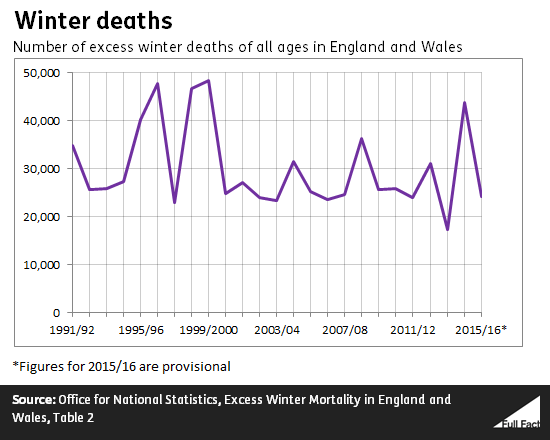“The Office for National Statistics has released figures showing that a staggering 24,300 people died from mostly preventable causes over the course of winter last year.”
Dan Jarvis MP, 29 November 2016
In 2015/16 there were 24,300 excess winter deaths in England and Wales, according to provisional figures from the ONS.
These excess deaths are calculated by comparing the number of deaths between December and March that year with the average number of deaths in the four months immediately before and after. The difference between the winter deaths and the average for the rest of the year is what is known as “excess winter deaths”.
Excess winter deaths were lower in 2015/16 compared to the previous year, and have returned to the average level over the past five years. The ONS says that one of the key reasons behind this was a decrease in the number of excess winter deaths among the elderly. The most common strain of flu virus affected younger people more than it did older people in 2015/16.
 More than a third of these excess deaths were due to respiratory diseases like flu or pneumonia (35%), followed by circulatory conditions like rheumatic fever (24%) and then dementia (18%).
More than a third of these excess deaths were due to respiratory diseases like flu or pneumonia (35%), followed by circulatory conditions like rheumatic fever (24%) and then dementia (18%).
In Scotland there were 2,850 excess winter deaths in 2015/16. In Northern Ireland there were 870 excess winter deaths in 2014/15, but in the years before this it had been around 500-600. (Figures for Northern Ireland have not yet been released for 2015/16.)
Honesty in public debate matters
You can help us take action – and get our regular free email
Excess winter deaths affect all ages
Around 14% of these excess winter deaths in England and Wales were people under the age of 65. Almost half were over the age of 85.
Excess winter deaths are higher in females than males, something which the ONS says may be partly explained by the higher proportion of females in the over-85 population.
For both men and women the number of excess winter deaths had decreased substantially compared to 2014/15. For women it had decreased by 50%, whereas for men it had decreased by 37%. Excess winter deaths in 2014/15 were particularly high compared with recent years and the figures are now back in line with the five-year average, according to the ONS.
Causes of excess winter deaths
So what causes a higher number of people to die during the winter than in the summer months? Well, it turns out the answer isn’t as simple as “the cold”.
The ONS says that countries with very low winter temperatures have a lower rate of excess winter deaths than countries with higher temperatures in winter months. It suggests that one reason this can lead to excess winter deaths is because “people who live in countries with warmer winters tend to take fewer precautions against the cold”, such as warmer clothes, home insulation and double glazing.
It also says “conditions directly relating to cold, such as hypothermia, are not the main cause of [excess winter deaths]” in England and Wales.
The National Institute for Health and Care Excellence has said that “in many cases simple preventive action could avoid many of the deaths and illnesses associated with the cold.”
 More than a
More than a